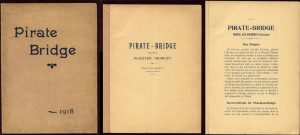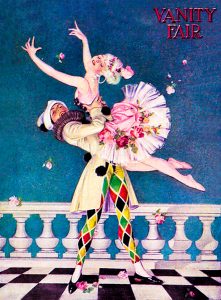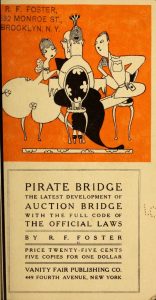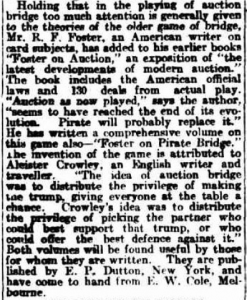From a little known chapter of Crowley’s life…
First published in Vanity Fair (Jan. 1917) Crowley introduced modifications to the game of Bridge which he termed “Pirate Bridge” – Though never having played Bridge I know it’s a competitive card game played in teams which remains popular throughout world. Even today Bridge Clubs are fairly common place in the United States – However Bridge was in its heyday during the early 1920’s through mid-1940’s in which tournaments, local and international, were quite popular. Though Crowley’s contributions were essentially minor alterations to the original game Pirate Bridge would none the less become somewhat of a fad which received a fair share of media attention. Crowley of course enjoyed the spot-light and for a brief moment wasn’t the world’s most evil man or even prophet of the new aeon… instead he was Aleister Crowley the inventor of Pirate’s Bridge, a gentleman (plus those other things). Speaking of this period Crowley fondly wrote, “I had only to wander into the appropriate circles to make myself the darling of the community.”
I’m including the text of two articles; the first – The Origin of the Game of Pirate Bridge – was written by Aleister Crowley and published in the January 1917 edition of Vanity Fair and the second is an article written for The Dominion out of Wellington, New Zealand and dated the 28th of December, 1918. Also included is an image of an article written for The Argus out of Melborne dated to October of 1918. These are just a few examples of the many articles which appeared world wide as enthusiasm for Crowley’s Pirate Bridge grew.
– The Origin of the Game of Pirate Bridge –
There are six major drawbacks to Auction Bridge. Here they are: 1. Mismated partners. You get a friend for a partner and can’t shake him off. 2. Mismated hands. The two good heart hands never seem to come together. The good spade partners are opposed to each other, etc., etc. 3. The frequency with which bids are set. In actual practice only nine bids out of thirteen are successful at auction. 4. The fact that you are liable all through a rubber, for your partner’s mistakes. 5. The bickering, fault-finding, nagging, and exhibitions of bad temper. 6. It is not a good game for the gambling type of player, as only two people can win-or lose-and they must always win or lose like amounts.
Last summer, during odd days, I worked at this sixfold problem-at the attempt to eliminate these six great drawbacks. I was alone, in camp, and had to puzzle it all out with three dummies before me,-but I worked hard at it, and suddenly the great idea dawned upon me: Choose your own partner!
Well, I developed that simple Great Idea and came to New York with the results of it. I went straight to the office of Vanity Fair, and, 10, great was my reward! The editor and I tried out a few hands at double dummy. He liked the game at once, and summoned to our aid that noted authority on every game from Scat to Poker, Mr. R. F. Foster. Mr. Foster also liked the game, and has worked at the theory of it pretty steadily ever since. He has introduced it to certain of the leading card clubs, and has even crystallized my crude idea into a pamphlet of official rules.
Luckily for the readers of Vanity Fair, it will be he who is to explain, month by month, to its card-loving subscribers the best way to combine pleasure with profit at Pirate Bridge. I must not encroach upon his province of scientific explanations, but I should like to point out six major advantages of the game of Pirate:
First: You can-if you are clever avoid tying yourself up with a tedious or idiotic partner.
Second: The hands which will work best together tend to come together as partners.
Third: Fewer final bids are set back, thus shortening the duration-and bother-of every rubber.
Fourth: Every player is playing for himself. Four individual scores are kept, all independent.
Fifth: It does away with a lot of bickering and quarreling. You may feel inclined to blame someone for “accepting” you, when the hand goes wrong; but you are not tied to him for a rubber.
Sixth: It is a first-rate game for the man who fancies his own individual play, and has many of the best elements of poker.
Let me draw a picture! In auction, I bid a heart, but only with fear and trembling, because my partner may not have any hearts at all. In the new game of Pirate I can bid two hearts and feet more or less certain that either the man-no matter where he sits-with the hearts or the man with the aces and kings, is going to accept me as a partner and so save me from ignominy and ruin. After a bid has been accepted, and a partnership thus established, the next player can accept that bid and so establish a new partnership, and so on indefinitely.
But, more delightful than anything else, is the change in the actual play introduced by the fact that partners are not always playing across the table. One’s dummy may be exposed across the table, or at one’s immediate right or left. Finessing, and “leading through,” become much more interesting and important when two partners are sitting next to each other. The whole technique of the play of the cards at once becomes a great deal more diversified, unexpected and subtle.
From – The Dominion –
Bridge players should welcome an authoritative guide to the latest development of auction bridge. Such a work is now provided by Foster’s “Pirate Bridge” (E. P. Dutton and Co., per Angus and Robertson and Whitcombe and Tombs). Mr. Foster is admittedly the best expert authority on card games, more especially the various latter-day developments of the good old game of whist. In an interesting sketch of the history of bridge, Mr. Foster credits a Mr. John Doe, an Anglo-Indian, with having invented auction bridge. It remained, he says, for Mr. Aleister Crowley to go a step further than Doe. The idea of auction bridge was to distribute the privilege of making the trump, giving everyone at the table a chance. Mr. Crowley improved upon this by distributing the privilege of picking the partner who could best support that trump, or who could offer the best defense against it. Instead of having all partnerships decided by their accidental position at the table, his plan was to have the partners select each other by a sort of proposal and acceptance, according to the suitability of their joint hands. Mr. Crowley explained his ideas to Mr. Crowninshield, the editor of the New York weekly “Vanity Fair,” who at once saw its possibilities, christened the new game “pirate bridge,” and introduced it to the card-playing world in a series of articles, the first of which was published in January 1917. Mr. Foster’s work deals with every stage and variation of the game, and offers advice as to the best play at each juncture. The chapters on bidding, accepting and refusing unsuitable partners are models of shrewd observational lucidity in expressing the counsel given. The rules of the game are given in full, and several illustrative games are worked out in detail.





